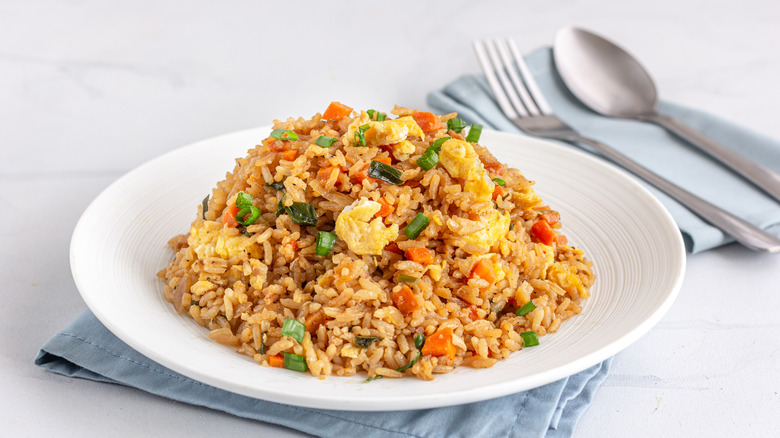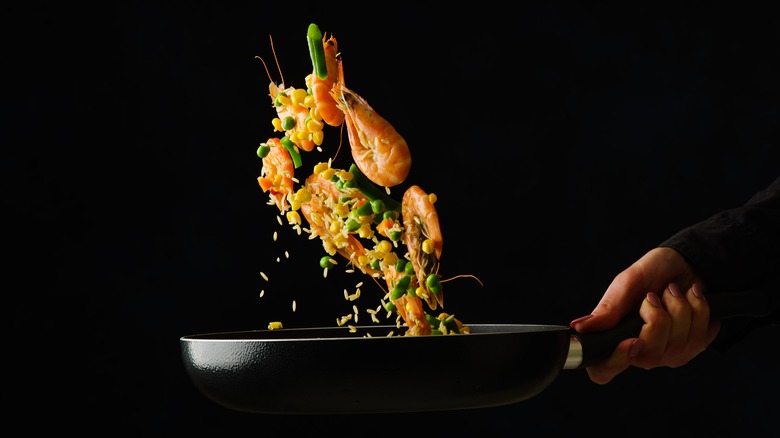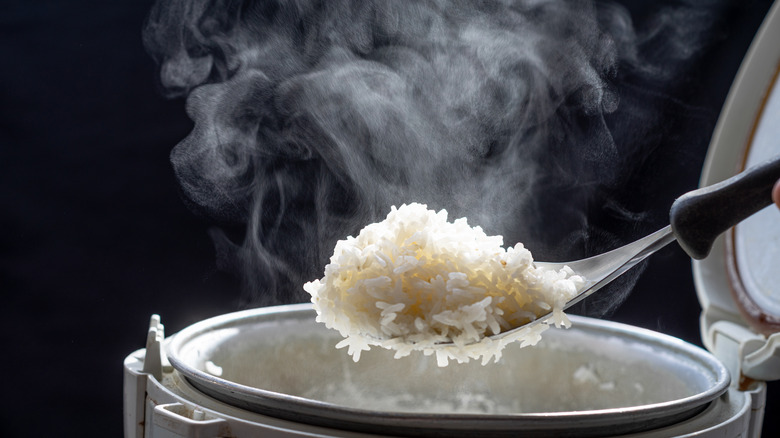Why You Shouldn't Make Fried Rice With Fresh Cooked Rice
Fresh ingredients are always better than old ones, right? In almost every scenario, the freshest possible ingredients available to us will yield the most flavorful, all-around best quality meals. But there are exceptions to every rule, and many chefs say fried rice is one of them. This comforting dish doubles as a vehicle for leftover meat, veggies, and — perhaps surprisingly — rice. You'll actually want to use somewhat dry, days-old leftover rice over a freshly-cooked batch.
This notion wasn't invented just to deal with the modern problem of leftovers hanging around in the fridge. Older batches of rice have been used in fried rice recipes for quite a long time. In order for the dish to develop the appropriate texture and flavor — with slightly crisp, toasty grains of rice that are separated, not clumped together – the rice you use should be as dry as possible. This isn't to say that fresh rice won't still taste great in your recipe, but it does increase the chances of producing a somewhat mushy, clumped-up version of the dish. The high moisture content of fresh rice is to blame — unless you use a few tricks to make fresh rice more dry and suitable for stir-frying.
Why leftovers and fried rice are a match made in heaven
Fried rice first emerged during China's Sui Dynasty, and was purportedly a favorite of Emperor Yang. By the 6th century, it became a meal that transcended classes, beloved for both its deliciousness and functionality. Made using pantry staples, seasonally-available ingredients, and yes, leftovers, the dish was easily modified to suit nobility and peasants alike. There's no official recipe to make it, and endless variations exist, but some tips apply to pretty much any recipe.
While using leftovers is part of the tradition of fried rice, there is also scientific justification for choosing cold, dry rice over fresh. A key element of fried rice is the texture — each grain is meant to be lightly toasted as it cooks, adding a delicious flavor and preventing it from clumping up. Since freshly-cooked rice is still soft and tacky to the touch — especially high-starch white rice varieties — it's more likely to become mushy. The grains stick to the pan's surface and to each other.
As rice cools, however, its starch molecules undergo a process called retrogradation, in which they crystallize and turn "firm enough to withstand the second round of cooking" (via America's Test Kitchen). Leftover rice is less likely to clump or break down, more likely to toast nicely, easier to toss in a wok, and the separate grains become more evenly coated in sauces and mix better with your add-ins, like chopped veggies and meat.
Prepared correctly, fresh rice will work, too
If you don't have day-old, leftover rice and a fried rice craving strikes, never fear — you just need to take some extra steps to give fresh rice a chance reach its fullest potential. While there are many kinds of rice to choose from, the best variety for takeout-worthy fried rice is jasmine rice. Portion out the rice and rinse it well, then briefly sauté it in hot oil to create an oily coating around each grain, which discourages the rice from clumping and removes some of its moisture.
Next, cook the rice in slightly less water than is called for in the directions. Once all the water has been absorbed, turn off the heat and leave the rice covered in the pan or rice cooker until it becomes tender. Then, scoop it onto a sheet pan, spread it out evenly, and pop it in the fridge or freezer until fully cooled.
Finally, heat up oil in a wok, then — working in batches if necessary — cook the rice until it develops a light brown color. Then push the rice to the sides of your pan, add more oil, and cook your proteins, vegetables, and aromatics before tossing them in with the rice. Add your chosen sauces, scrambled eggs, some last-minute frozen peas, and any other ingredients you use to upgrade your fried rice. Give it all a final toss to combine, then serve and enjoy.



